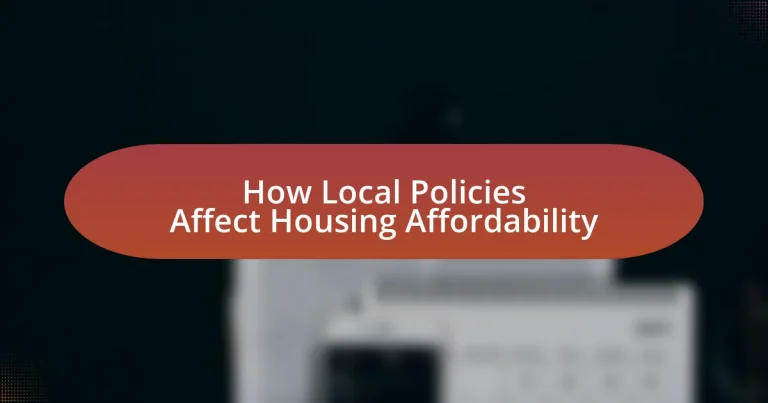Local policies play a crucial role in shaping housing affordability through regulations on land use, zoning, and development practices. The article examines how various local policies, including zoning regulations, land use policies, and housing development incentives, directly impact housing supply, demand, and pricing. It highlights the effects of restrictive zoning laws on housing costs, the influence of property taxes on homeownership affordability, and the benefits of effective policies like inclusionary zoning and rent control. Additionally, the article discusses the challenges local governments face in implementing these policies and the importance of community engagement and data analysis in developing effective housing strategies.

How do local policies influence housing affordability?
Local policies significantly influence housing affordability by regulating land use, zoning, and development practices. For instance, policies that promote high-density housing can increase the supply of affordable units, while restrictive zoning laws can limit development and drive up prices. According to a study by the National Association of Realtors, areas with more flexible zoning regulations tend to have lower housing costs, demonstrating that local governance directly impacts market dynamics. Additionally, policies that provide incentives for affordable housing development, such as tax credits or subsidies, can further enhance affordability by encouraging builders to create lower-cost options.
What types of local policies impact housing markets?
Local policies that impact housing markets include zoning regulations, land use policies, and housing development incentives. Zoning regulations dictate the types of buildings allowed in specific areas, influencing housing density and availability. For example, restrictive zoning can limit the construction of multi-family units, thereby reducing housing supply and increasing prices. Land use policies determine how land can be utilized, affecting the availability of land for residential development. Additionally, housing development incentives, such as tax breaks or subsidies for affordable housing projects, can encourage developers to build more units, directly impacting housing affordability. These policies collectively shape the dynamics of local housing markets by influencing supply, demand, and pricing.
How do zoning laws affect housing supply and demand?
Zoning laws significantly influence housing supply and demand by regulating land use, density, and the types of housing that can be built in specific areas. These regulations can restrict the construction of new housing units, thereby limiting supply, which often leads to increased housing prices due to higher demand in desirable locations. For instance, a study by the National Bureau of Economic Research found that restrictive zoning laws in urban areas can lead to a 20% increase in housing prices, as they prevent the development of affordable housing options. Consequently, when zoning laws are overly restrictive, they can exacerbate housing shortages and affordability issues, making it difficult for lower-income families to find suitable housing.
What role do property taxes play in housing affordability?
Property taxes significantly impact housing affordability by influencing the overall cost of homeownership. High property taxes can increase monthly housing expenses, making it more difficult for potential buyers to afford homes. For instance, a study by the National Association of Home Builders found that a 1% increase in property tax can reduce housing affordability by approximately 10%. This relationship indicates that as property taxes rise, the financial burden on homeowners and prospective buyers increases, potentially leading to decreased demand for housing and a slowdown in the housing market.
Why is understanding local policies crucial for housing affordability?
Understanding local policies is crucial for housing affordability because these regulations directly influence the availability, cost, and quality of housing in a community. Local policies, such as zoning laws, land use regulations, and housing incentives, determine how land can be developed and what types of housing can be built. For instance, restrictive zoning can limit the construction of affordable housing units, thereby exacerbating housing shortages and increasing prices. According to the National Low Income Housing Coalition, in many areas, the lack of affordable housing options is linked to local policies that favor single-family homes over multi-family developments, which can provide more affordable units. Thus, comprehending these policies enables stakeholders to advocate for changes that promote housing affordability and address community needs effectively.
How can local policies create barriers to affordable housing?
Local policies can create barriers to affordable housing by implementing zoning regulations that restrict the types of housing that can be built. For instance, many municipalities enforce single-family zoning, which limits the construction of multi-family units, thereby reducing the overall housing supply and driving up prices. According to a study by the National Multifamily Housing Council, areas with restrictive zoning laws often experience higher housing costs, making it difficult for low- and moderate-income families to find affordable options. Additionally, local policies may impose high development fees and lengthy approval processes, further discouraging developers from pursuing affordable housing projects. These factors collectively contribute to a significant shortage of affordable housing in many communities.
What are the potential benefits of effective local housing policies?
Effective local housing policies can lead to increased housing affordability, improved community stability, and enhanced economic growth. By implementing zoning reforms and incentivizing affordable housing development, local governments can reduce housing costs for residents. For instance, cities that have adopted inclusionary zoning policies often see a rise in the availability of affordable units, which can lower overall market prices. Additionally, effective policies can promote mixed-income neighborhoods, fostering social diversity and reducing economic segregation. Research indicates that areas with stable housing markets experience lower crime rates and better educational outcomes, demonstrating the broader societal benefits of well-structured housing policies.

What are the key local policy tools for addressing housing affordability?
Key local policy tools for addressing housing affordability include inclusionary zoning, rent control, and housing vouchers. Inclusionary zoning mandates that a percentage of new developments be affordable for low- to moderate-income households, which directly increases the supply of affordable housing. Rent control limits the amount landlords can increase rent, helping to stabilize housing costs for existing tenants. Housing vouchers provide financial assistance to low-income families, allowing them to afford housing in the private market. These tools have been implemented in various cities, demonstrating their effectiveness in mitigating housing affordability issues. For instance, cities like San Francisco and New York have utilized inclusionary zoning and rent control to address their housing crises, resulting in a more diverse and economically balanced community.
How do inclusionary zoning policies work?
Inclusionary zoning policies require developers to include a certain percentage of affordable housing units in new residential projects. These policies aim to increase the supply of affordable housing by mandating that a portion of the units be set aside for low- to moderate-income households, often in exchange for incentives such as density bonuses or tax breaks. For example, a city may require that 15% of units in a new development be affordable, thereby directly contributing to the availability of housing options for lower-income residents. Studies have shown that inclusionary zoning can effectively increase affordable housing stock; for instance, a report from the Urban Institute found that cities with such policies saw a significant rise in affordable units compared to those without.
What are the advantages and disadvantages of inclusionary zoning?
Inclusionary zoning has the advantage of increasing the supply of affordable housing by requiring developers to include a percentage of affordable units in new residential projects. This policy can help address housing shortages and promote socioeconomic diversity within communities. For instance, cities like San Francisco and New York have implemented inclusionary zoning, resulting in thousands of affordable units being created.
However, the disadvantages include potential increases in housing costs for market-rate units, as developers may raise prices to offset the costs of including affordable units. Additionally, inclusionary zoning can lead to reduced overall housing production if developers find the requirements financially unfeasible, which can exacerbate housing shortages. Studies have shown that in some markets, such as in parts of California, the implementation of inclusionary zoning has led to a decrease in new housing developments.
How do these policies affect developers and low-income residents?
Local policies significantly impact developers and low-income residents by shaping the availability and affordability of housing. For developers, policies such as zoning regulations and building codes can either facilitate or hinder the construction of new housing projects, influencing their financial viability. For instance, restrictive zoning can limit the types of housing that can be built, thereby reducing the overall supply and increasing costs. Conversely, incentives like tax breaks or density bonuses can encourage developers to create more affordable housing options.
For low-income residents, these policies directly affect their access to affordable housing. When local governments implement policies that promote affordable housing development, such as inclusionary zoning, it can lead to an increase in available units that are financially accessible. However, if policies favor high-end developments or do not include provisions for affordable housing, low-income residents may face displacement and a lack of suitable housing options. Studies have shown that areas with strong affordable housing policies tend to have lower rates of homelessness and better overall community stability.
What is the impact of rent control policies?
Rent control policies primarily aim to make housing more affordable by limiting the amount landlords can charge for rent. These policies can lead to reduced rental prices for existing tenants, providing them with financial relief. However, they may also result in decreased investment in rental properties, as landlords may find it less profitable to maintain or improve their buildings. Research indicates that cities with strict rent control often experience a decline in the overall quality of housing stock, as landlords may cut back on maintenance and renovations due to reduced revenue. Additionally, rent control can create a mismatch in the housing market, leading to shortages of available rental units, as new construction may be discouraged. For example, a study by the National Bureau of Economic Research found that rent control in San Francisco led to a significant reduction in the supply of rental housing, exacerbating affordability issues in the long term.
How do rent control measures influence tenant stability?
Rent control measures significantly enhance tenant stability by limiting rent increases, which helps tenants maintain affordable housing over time. These regulations create a predictable rental environment, reducing the risk of displacement due to sudden rent hikes. For instance, a study by the National Bureau of Economic Research found that cities with rent control experience lower rates of tenant turnover, indicating that tenants are more likely to remain in their homes. This stability is crucial for fostering community ties and reducing the stress associated with housing insecurity.
What are the economic implications of rent control on housing supply?
Rent control typically leads to a decrease in housing supply. When rent is capped, landlords may find it less profitable to maintain or invest in rental properties, resulting in reduced incentives to build new housing units. A study by the National Bureau of Economic Research found that cities with strict rent control laws experienced a significant decline in the construction of new rental housing, with estimates suggesting a reduction of up to 15% in housing supply over time. This contraction in supply can exacerbate housing shortages, leading to increased competition for available units and ultimately driving up prices in the uncontrolled segments of the market.

How can local governments improve housing affordability through policy changes?
Local governments can improve housing affordability through policy changes by implementing inclusionary zoning, which mandates that a percentage of new developments be affordable for low- and moderate-income households. This approach has been adopted in cities like San Francisco, where inclusionary zoning has resulted in the creation of thousands of affordable units, thereby directly addressing the housing crisis. Additionally, local governments can streamline the permitting process to reduce development costs, as seen in Minneapolis, where reforms led to a significant increase in housing supply. These policy changes not only enhance affordability but also promote diverse and sustainable communities.
What best practices can local governments adopt to enhance housing affordability?
Local governments can enhance housing affordability by implementing inclusionary zoning policies that require a percentage of new developments to be affordable for low- and moderate-income households. This approach has been shown to increase the supply of affordable housing; for instance, cities like San Francisco and New York have successfully integrated such policies, resulting in thousands of affordable units being created. Additionally, local governments can streamline the permitting process to reduce costs and delays for developers, which can lead to lower housing prices. Research indicates that cities with expedited permitting processes see a significant increase in housing production, thereby improving affordability. Furthermore, local governments can invest in public-private partnerships to leverage private funding for affordable housing projects, as evidenced by successful initiatives in places like Seattle, where collaboration has led to the development of mixed-income communities.
How can community engagement shape effective housing policies?
Community engagement can shape effective housing policies by ensuring that the needs and preferences of residents are directly reflected in policy decisions. When local governments actively involve community members in the planning and decision-making processes, they gain valuable insights into the specific housing challenges and desires of the population. For instance, studies have shown that participatory planning approaches lead to more equitable and sustainable housing solutions, as they incorporate diverse perspectives and foster collaboration among stakeholders. Evidence from the Urban Institute indicates that neighborhoods with strong community engagement initiatives experience better housing outcomes, such as increased affordability and improved living conditions. This demonstrates that when residents are empowered to voice their concerns and contribute to policy formulation, the resulting housing policies are more likely to be effective and responsive to the community’s actual needs.
What role does data analysis play in developing housing strategies?
Data analysis plays a critical role in developing housing strategies by providing insights into housing trends, demographics, and market conditions. By analyzing data such as population growth, income levels, and housing supply, policymakers can identify areas of need and tailor strategies to address specific housing challenges. For instance, a study by the Urban Institute found that data-driven approaches can lead to more effective allocation of resources, resulting in improved housing affordability and accessibility. This evidence underscores the importance of data analysis in informing local policies that directly impact housing affordability.
What are the common challenges local governments face in implementing housing policies?
Local governments commonly face challenges such as limited funding, regulatory constraints, and community opposition when implementing housing policies. Limited funding restricts the ability to develop affordable housing projects, as many local governments rely on state and federal grants that may not meet the demand. Regulatory constraints, including zoning laws and building codes, can hinder the speed and flexibility needed to adapt housing solutions to local needs. Additionally, community opposition, often referred to as NIMBYism (Not In My Backyard), can obstruct new developments, as residents may resist changes that they perceive as threatening to their neighborhoods. These challenges collectively impede the effectiveness of housing policies aimed at improving affordability.
How can local governments overcome resistance to policy changes?
Local governments can overcome resistance to policy changes by actively engaging with the community and stakeholders to build trust and understanding. Effective communication strategies, such as public forums and informational campaigns, can clarify the benefits of proposed policies, particularly in the context of housing affordability. For instance, a study by the Urban Institute found that inclusive community engagement significantly increases public support for housing policies, as it allows residents to voice concerns and contribute to solutions. By demonstrating how policy changes can lead to improved housing affordability and community well-being, local governments can mitigate opposition and foster collaborative efforts toward implementation.
What strategies can be employed to ensure equitable housing access?
To ensure equitable housing access, implementing inclusionary zoning policies is essential. Inclusionary zoning requires developers to include a percentage of affordable units in new housing projects, thereby increasing the availability of affordable housing options in diverse neighborhoods. Research from the Urban Institute indicates that cities with inclusionary zoning have seen a significant increase in affordable housing stock, which helps to mitigate displacement and promote socioeconomic diversity. Additionally, providing financial assistance programs for low-income families can further enhance access to housing, as evidenced by studies showing that rental assistance leads to improved housing stability and better overall outcomes for families.




